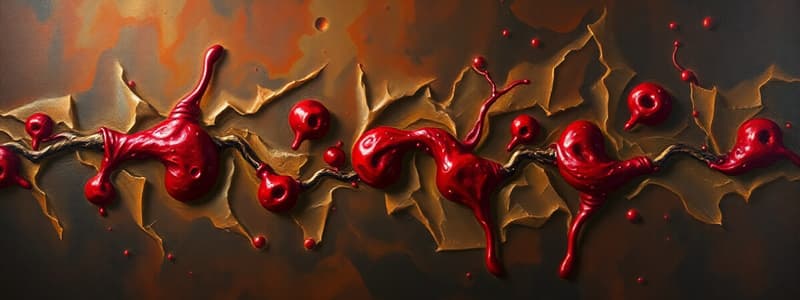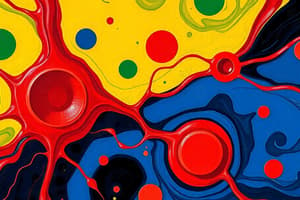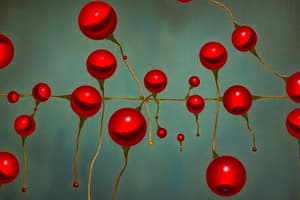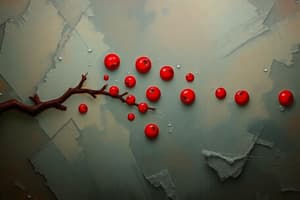Podcast
Questions and Answers
Quale es un passo initial in le pathway intrinsic de coagulation?
Quale es un passo initial in le pathway intrinsic de coagulation?
- Produxe factores de coagulatio
- Fibrinogen
- Danno del vaso (correct)
- Activar plateletas
Quale factor es essential in le pathway extrinseco?
Quale factor es essential in le pathway extrinseco?
- Factor 8
- Factor 11
- Fibrinogen
- Tissue factor (III) (correct)
Quale affirmatio super le factor 9 es ver?
Quale affirmatio super le factor 9 es ver?
- Su absentia causa un forma rar de hemophilia. (correct)
- Es principal in le pathway extrinseco.
- Produce profunde retroactions positive.
- Activate le plateletas sin cofactores.
Quale cofactor es necessario pro le production de prothrombin?
Quale cofactor es necessario pro le production de prothrombin?
Quale es le rol del thrombin (IIa) in le cascade de coagulation?
Quale es le rol del thrombin (IIa) in le cascade de coagulation?
Flashcards
Via intrinsic
Via intrinsic
Le processo de coagulation sanguinee, comenciante con le contacto de factor 12 con collageno. Iste pathway involve le factores 12, 11, 9, 8, e 10, e culmina in le activation de thrombin (factor 2a).
Via extrinsic
Via extrinsic
Le processo de coagulation sanguinee, incipiente con le exposition de factor tissular (factor 3) a le sanguine. Iste process involve le factores 7, 10, e 2, e culmina in le activation de thrombin (factor 2a).
Factor 12
Factor 12
Un proteina que es activate per le contacto con collageno, initiante le via intrinsic de coagulation.
Prothrombin (factor 2)
Prothrombin (factor 2)
Signup and view all the flashcards
Factor 13
Factor 13
Signup and view all the flashcards
Study Notes
Clotting Cascade
- The intrinsic pathway is initiated by contact activation, exposed collagen triggers the activation of factor 12.
- Factor 12 activates factor 11, which activates factor 9.
- Factor 9, with factor 8 and phospholipid cofactor initiate a cascade leading to activation of factor X.
- Factor 10 activation leads to prothrombin conversion to thrombin.
- The common pathway leads to thrombin, which converts fibrinogen into fibrin.
- The extrinsic pathway is initiated by damage to subendothelial cells and tissue, releasing tissue factor; activating factor VII, which activates factor X.
- The intrinsic and extrinsic pathways converge on factor X.
- Activated factor X, along with factor V and phospholipid cofactor, activate prothrombin to thrombin.
- Thrombin converts fibrinogen to fibrin, forming a clot.
- Thrombin and factor 13 crosslink fibrin fibers.
- Platelets contribute to the clotting cascade by releasing factors that promote clot formation at the injured site, and aggregating at the injury site.
- Vitamin K is required by the liver to synthesize some clotting factors.
- Negative feedback loops regulate the clotting cascade.
Studying That Suits You
Use AI to generate personalized quizzes and flashcards to suit your learning preferences.




